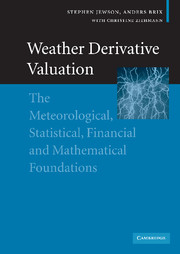 Weather Derivative Valuation
Weather Derivative Valuation Book contents
- Frontmatter
- Contents
- List of figures
- List of tables
- Acknowledgements
- 1 Weather derivatives and the weather derivatives market
- 2 Data cleaning and trends
- 3 The valuation of single contracts using burn analysis
- 4 The valuation of single contracts using index modelling
- 5 Further topics in the valuation of single contracts
- 6 The valuation of single contracts using daily modelling
- 7 Modelling portfolios
- 8 Managing portfolios
- 9 An introduction to meteorological forecasts
- 10 The use of meteorological forecasts in pricing
- 11 Arbitrage pricing models
- 12 Risk management
- 13 Modelling non-temperature data
- A Trend models
- B Parameter estimation
- C Goodness of fit tests
- D Expected pay-offs for normally distributed indices
- E Pay-off variances for normally distributed indices
- F Greeks for normally distributed indices
- G Exact solutions for the kernel density
- H The beta for a normally distributed index
- I Simulation methods
- J Efficient methods for pricing against a portfolio
- References
- Index
1 - Weather derivatives and the weather derivatives market
Published online by Cambridge University Press: 22 September 2009
- Frontmatter
- Contents
- List of figures
- List of tables
- Acknowledgements
- 1 Weather derivatives and the weather derivatives market
- 2 Data cleaning and trends
- 3 The valuation of single contracts using burn analysis
- 4 The valuation of single contracts using index modelling
- 5 Further topics in the valuation of single contracts
- 6 The valuation of single contracts using daily modelling
- 7 Modelling portfolios
- 8 Managing portfolios
- 9 An introduction to meteorological forecasts
- 10 The use of meteorological forecasts in pricing
- 11 Arbitrage pricing models
- 12 Risk management
- 13 Modelling non-temperature data
- A Trend models
- B Parameter estimation
- C Goodness of fit tests
- D Expected pay-offs for normally distributed indices
- E Pay-off variances for normally distributed indices
- F Greeks for normally distributed indices
- G Exact solutions for the kernel density
- H The beta for a normally distributed index
- I Simulation methods
- J Efficient methods for pricing against a portfolio
- References
- Index
Summary
Introduction
This book is about the valuation of a certain class of financial contracts known as weather derivatives. The purpose of weather derivatives is to allow businesses and other organisations to insure themselves against fluctuations in the weather. For example, they allow natural gas companies to avoid the negative impact of a mild winter when no one turns on the heating, they allow construction companies to avoid the losses due to a period of rain when construction workers cannot work outside and they allow ski resorts to make up for the money they lose when there is no snow.
The weather derivatives market, in which contracts that provide this kind of insurance are traded, first appeared in the US energy industry in 1996 and 1997. Companies accustomed to trading contracts based on electricity and gas prices in order to hedge their electricity and gas price risk realised they could trade contracts based on the weather and hedge their weather risk in the same way. The market grew rapidly and soon expanded to other industries and to Europe and Japan. Volatility in the financial markets has meant that not all of the original participants are still trading, but the weather derivatives market has steadily grown and there are now a number of energy companies, insurance companies, reinsurance companies, banks and hedge funds that have groups dedicated purely to the business of buying and selling weather derivatives.
- Type
- Chapter
- Information
- Weather Derivative ValuationThe Meteorological, Statistical, Financial and Mathematical Foundations, pp. 1 - 36Publisher: Cambridge University PressPrint publication year: 2005
- 1
- Cited by
